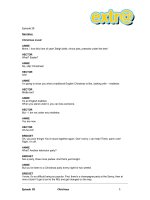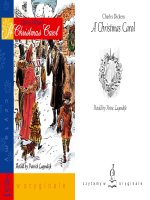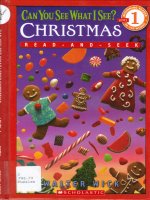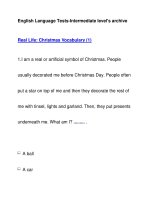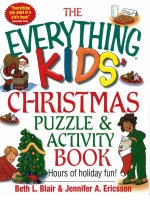809 christmas
Bạn đang xem bản rút gọn của tài liệu. Xem và tải ngay bản đầy đủ của tài liệu tại đây (138.96 KB, 3 trang )
Christmas and the New Year
in Britain
There are lots of Christmas and New Year traditions in Britain.
For example...
London's Christmas decorations. Every year the
people of Norway give the city of London a present… It's a
big Christmas tree and it stands in Trafalgar Square. Also in
central London, Oxford Street and Regent Street always have
beautiful decorations at Christmas. Thousands of people come to look at them.
Cards, trees and mistletoe. In 1846 the first Christmas cards began in Britain.
That was five years after the first Christmas tree. Queen Victoria's husband, Prince
Albert, brought this German tradition (he was German) to Britain. He and the Queen had
a Christmas tree at Windsor Castle in 1841. A few years after, nearly every house in
Britain had one.
Traditionally people decorate their trees on Christmas Eve - that's December 24th.
They take down the decorations twelve days later, on Twelfth Night (January 5th).
An older tradition is Christmas mistletoe. People put a piece of this green plant with
its white berries over a door. Mistletoe brings good luck, people say. Also, at Christmas
British people kiss their friends and family under the mistletoe.
Carols. Before Christmas, groups of singers go from house to house. They collect
money and sing traditional Christmas songs or carols. There are a lot of very popular
British Christmas carols. Three famous ones are:
"Good King Wenceslas", "The Holly and The Ivy" and "We Three Kings".
Christmas Eve. British children don't open their presents on December 24th.
Father Christmas brings their presents in the night. Then they open them on the morning
of the 25th.
There's another name for Father Christmas in Britain - Santa Claus. That comes
from the European name for him - Saint Nicholas. In the traditional story he lives at the
North Pole. But now he lives in big shops in towns and cities all over Britain. Well,
that's where children see him in November and December. Then on Christmas Eve he
visits every house. He climbs down the chimney and leaves lots of presents. Some
people leave something for him, too. A glass of wine and some biscuits, for example.
Christmas Day. In Britain the most important meal on December 25th is
Christmas dinner. Nearly all Christmas food is traditional, but a lot of the traditions are
not very old. For example, there were no turkeys in Britain before 1800. And even in the
nineteenth century, goose was the traditional meat at Christmas. But not now.
A twentieth-century British Christmas dinner is roast turkey with carrots, potatoes,
peas, Brussels sprouts and gravy. There are sausages and bacon too. Then, after the
turkey, there's Christmas pudding. You can read about that in the chapter on food.
Crackers are also usual at Christmas dinner. These came to Britain from China in
the nineteenth century. Two people pull a cracker. Usually there's a small toy in the
middle. Often there's a joke on a piece of paper, too. Most of the jokes in Christmas
crackers are not very good. Here's an example:
CUSTOMER: Waiter, there's a frog in my soup.
WAITER: Yes, sir, the fly's on holiday.
Boxing Day. December 26th is Boxing Day. Traditionally boys from the
shops in each town asked for money at Christmas. They went from house to
house on December 26th and took boxes made of wood with them. At each
house people gave them money. This was a Christmas present. So the name of
December 26th doesn't come from the sport of boxing - it comes from the boys' wooden
boxes. Now, Boxing Day is an extra holiday after Christmas Day.
First Footing. In Scotland the name for New Year's Eve is Hogmanay. After
midnight people visit their friends. And they take a present - a piece of coal. Why?
Because traditionally the first visitor of the year must carry coal into the house. This is
"first footing". It brings good luck. It also helps to make a fire in the middle of winter.
New Year Resolutions. What are your worst faults? Do you want to change
them? In Britain a lot of people make New Year Resolutions on the evening of
December 31st. For example, "I'll get up early every morning next year." or ''I'll clean
my shoes every day.'' But there's a problem. Most people forget their New Year
Resolutions on January 2nd.
THE QUEEN'S CHRISTMAS SPEECH
Now here's a modern royal custom. On Christmas Day at 3.00 in the afternoon the
Queen makes a speech on radio and TV. It's ten minutes long. In it she talks to the
people of the United Kingdom and the Commonwealth. The Commonwealth is a large
group of countries. In the past they were all in the British Empire. Australia, India,
Canada and New Zealand are among the 49 members.
The B.B.C. (the British Broadcasting Corporation) sends the Queen's speech to
every Commonwealth country. In her speech the Queen talks about the past year.
Traditionally in speeches, kings or queens say “we” not “I”. Queen Elizabeth II doesn't
do this. She says “My husband and I” or just 'I''.
The Queen doesn't make her speech on Christmas Day. She films it a few weeks
before. Then she spends Christmas with her family at Windsor. Does she watch the
speech on TV? Nobody knows.
Jingle, bells!
Dashing through the snow
In a one horse open sleigh
Over the fields we go
Laughing all the way.
Bells on bobtail ring
Making spirits bright
What fun it is to ride
And sing a sleighing song tonight.
A day or two ago
I thought I’d have a ride
And soon Mrs. Funny Bright
Was seated by my side
The horse was lean and lank
Misfortune seemed his lot
He got into a drifted bank
And we, we got up sot!
Jingle bells, Jingle bells,
Jingle all the way!
Oh, what fun it is to ride
In a one horse open sleigh!


